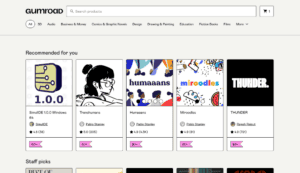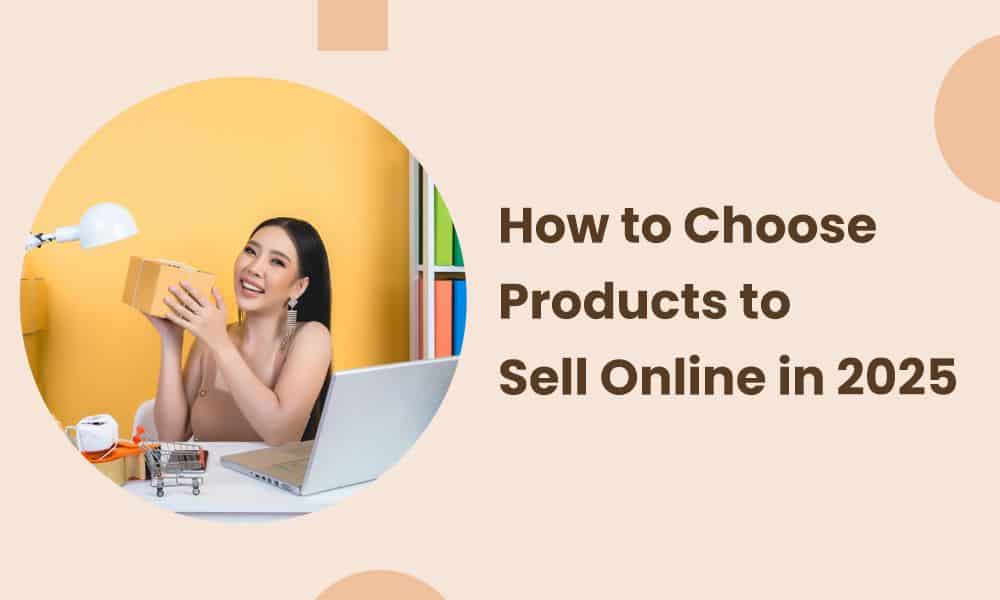Determining what your eCommerce store should sell is one of the hardest business decisions you’ll ever make.
With millions of products and categories, you can take your online business in so many directions. However, that can leave you with a nasty case of analysis paralysis. You want to become unstuck, making a confident decision about what kinds of products to sell.
Well, you’ve come to the right place, as you’ll learn the basics of choosing products to sell online.
In this blog post, we’ll show you how to choose products to sell online. We’ll also explore how to evaluate market demand and analyze profitability, as well as five great examples from successful brands.
Table of Contents
Key Takeaways
- Selecting the right eCommerce products for your brand requires audience research, competitor analysis, and a firm understanding of market demand.
- Even if you specialize in a certain product, if it isn’t profitable, it’s not worth manufacturing on a larger scale. That’s why you must always gauge how profitable a product is.
Identifying Trending Products
Trends come, and trends go, and while you shouldn’t hang your hat on them because of their fluidity, you can’t ignore trends altogether, either. The key is a balance somewhere in between when choosing products to sell online.
After all, tapping into trending products and categories determines higher-than-average interest and a potentially larger audience.
How do you find trending products? Let’s discuss.
Use social media
One of your biggest touchpoints for product popularity is social media. TikTok, especially, is where many product trends are born these days (I’m looking at you, Stanley bottle), and the products aren’t all necessarily brand new. Sometimes, what’s old becomes new again.
Don’t only use TikTok. Get on Facebook and search for products. Review the trends on Twitter. Click the Explore links on YouTube.
Social media is an excellent, efficient way to put your finger on what’s hot to determine where your products fit in or what kinds of niche products you should create.
Try Google Trends
If you have a Google account (which I’m sure you do as an eCommerce business owner), you can glean insights on what’s hot via Google Trends.
This free tool lets you refine your results by daily and real-time search trends in locations worldwide.
You can go deeper if you want. Beyond selecting which part of the planet the search emanated from, you can also choose specific timeframes (such as the last week, the last 90 days, or the last year), the type of search (web search, image search, etc.), and categories.
The available categories include many retail types, like video game retailers, food retailers, and book retailers.
After performing a search, Google Trends produces a graph showing the search term’s popularity over time, usually within the last several months. The only downside is that Google Trends provides no search context, but it’s still excellent for a free tool.
Review product best sellers on major markets
The next time you log into Amazon and other major retailers like them, check their bestsellers. Even if those products don’t necessarily appeal to you, that’s fine, as you’re not doing any shopping for yourself.
Instead, you’re doing this exercise to see what’s selling. If you make products like the bestsellers, then you’re in luck! Your eCommerce site has a better chance of succeeding in the marketplace.
However, if what you sell is at odds with what’s trending, you could wait until your product’s time comes or retool your ideas.
Watch your competitors
You should always monitor the competition, especially the more experienced eCommerce names in your niche or industry. They have done it all before you, and they know what works versus what doesn’t.
If their products sell, that tells you there’s a high demand for those goods. You shouldn’t necessarily produce the same goods unless yours are of superior quality. Otherwise, there’s little reason for potential customers to choose your eCommerce store, the newcomer, over your more established competitor.
Instead, use this information as the springboard for creating an awesome product in that same vein.
Ask your audience
If you’re still wondering how to choose great products to sell, ask the ones who will (hopefully) buy them: your target audience!
Connect with your target market via surveys or interviews, picking their brains about what kind of product they’d like to see. Compare their preferences against current trends.
Keep up with influencers
You should also follow a few influencers and learn which products have caught their eye recently. Review their respective audience’s reactions to the products to see which generates the most excitement.
What are the most popular eCommerce products in 2025?
The eCommerce products having a banner year in 2025 are wellness products, tech gadgets, and eco-friendly items.
Read more: The Benefits of Influencer Marketing
How to Evaluate Market Demand
As I said before, you can’t live or die by trends. They’re only a piece of the pie that is selling products people want. Market demand is another larger piece.
Market demand indicates whether people are interested in your products and, if so, who. The higher the rate of market demand, the more people are willing to pay for a product, meaning you can sell it for a higher price.
Oppositely, a low market demand might mean dipping below even the industry average for a product. Those kinds of products will quickly leave your eCommerce business in the red.
So, how do you determine whether your product ideas have any market demand? You have many methods at your disposal, so let’s look.
Market identification
Before you research market demand, you must whittle down your results according to your niche market. A niche market is usually extremely profitable, especially if you enter an underpopulated one.
However, it all depends on which niche you choose. For example, if you have a niche product related to a popular industry, then yes, you have a higher chance of appealing to a large audience. That said, if your product is in a niche virtually no one has heard of, that won’t bode well for profitability.
Competitor analysis
Yes, I once again implore you to look at your competitors. Their online sales data will tell you where your industry’s demand level is. If they’re in a niche or industry similar to yours and are doing well, your eCommerce business could also probably succeed.
Audience surveys
Again, I’m advocating for audience data because the best way to get audience information about product preferences is to go straight to the source. That said, you have to consider your sample size.
If your target market has 2,500 people (just using a small number for the sake of an example), and only 500 people respond, you’re not getting the majority opinion.
That doesn’t mean you should discard what those 500 people said, but be aware of the sample size in relation to the overall size of your audience.
SEO tools
You might wonder what SEO might do with finding the right products to sell, and the answer is a lot.
Ahrefs, SEMrush, and other SEO tools can point you in the direction of which keywords are ranking well. These terms have performed so optimally because people are eagerly searching for them.
That indicates interest, which, when corroborated with the other methods you’ve used, can further help you narrow down your product focus.
Read more: Master Customer Data — A Guide to Capturing, Analyzing, and Using Customer Insights
How to Analyze Profitability
By this point, I bet you’re getting closer to imagining what products you want to sell, right? This is an exciting time, no doubt, but you can’t decide until you determine how financially viable your product is.
There’s what’s known as a product profitability analysis that will be of great assistance to you as you enter this stage. The analysis will indicate whether your product can make a profit.
You only need to follow four simple steps to conduct a product profitability analysis, so it couldn’t be easier. Let’s take a look at how to do it.
Step 1
First, add up the overall product revenue. Now, I should mention that revenue and profit aren’t the same.
Sure, they’re both money in your pocket, but if you go by that metric, you’ll miscalculate the revenue and screw up the whole profitability analysis. That only hurts your eCommerce business in the end.
The money your eCommerce company makes when you sell a product is revenue. As you begin earning more revenue, your generational income is your profit.
So, if you made $6,000 in sales last month, that’s your revenue.
Step 2
Once you’ve added the numbers, you can calculate direct costs, the second step of a product profitability analysis. Again, this is a specific term, so I want to be sure you’re clear on it and what it means.
Direct costs refer to the prices associated with manufacturing your product. For example, if you specialize in hoodies, direct costs would include the materials, printing, picking, packaging, shipping, transportation, and delivery.
Add the direct costs to the overall product revenue.
Step 3
Next, you need to know your indirect costs. These are the costs indirectly associated with manufacturing your product. For example, you had to buy or lease warehousing space, an indirect expense.
So, too, are the salaries of the employees working at the warehouse, the utilities to keep the facility running, and office equipment.
Add indirect costs to the tally you have to this point.
Step 4
Then, there’s the last step, calculating the value of direct and indirect costs and subtracting that number from your total revenue.
Did you get a negative number? Bummer, as that means your product will not drive a profit. However, if you get a positive number, your product is a money-maker.
Read more: Revenue vs Profit — A Simple Explanation of Income
How to Select Products Based on Business Model
One of the reasons eCommerce has caught on like hotcakes is that there are different business models to explore, from private labels to wholesale and dropshipping.
However, the types of products best for your eCommerce business can vary depending on which business model you utilize.
Please join me as I guide you on which products you should focus on depending on the business model you follow.
Dropshipping
The dropshipping business model is a low-risk eCommerce category where you rely on suppliers for most of the fulfillment process. A customer places an order on your website, then you notify the supplier, and they’ll pick, pack, and ship the order.
You just have to focus on choosing products to sell online.
The eCommerce world can’t get enough of dropshipping, as evidenced by its global market in 2025, which is poised to hit $301.11 billion. In 2023, that number was only $243.42 billion.
So, what’s jumping out at consumers as the biggest products in the dropshipping sector in 2025? Here are some options to explore:
- Gaming products, including headphones, chairs, controller skins, computer monitors, mice, desks, and mousepads.
- Sustainable products include beeswax wraps, organic clothing, metal straws, plant-based household products, reusable produce bags, tote bags, and diapers.
- Tech equipment like webcams, memory cards, modems, SSD adapters, wireless routers, tablets, portable chargers, phone cases, screen protectors, phone tripods, phone mounts, and selfie sticks.
- Car accessories, including air fresheners, seat covers, parking sensors, wiper blades, GPS navigators, steering wheel covers, floor mats, and leather conditioners.
- Home improvement tools, from air purifiers to solar lights for outdoors, hanging wall hooks, step ladders, cordless drills, welders, and security cameras.
- Office products like file folders, pens and pencils, laptop stands, ink cartridges, sticky notes and lined paper, permanent markers, dry-erase boards and pens, desk organizers, and noise-canceling headphones.
- Home décor for every room in the home and even seasonal décor (especially for Christmas).
- Pet accessories such as food bowls, pet grooming supplies, dog crates, pet food, cat litter, pet beds, pet toys, treat dispensers, and harnesses and collars.
- Baby products include strollers, bibs, bottles, pacifiers, white noise machines, wipes, toys, diapers, clothes, and blankets.
- Beauty and skincare products include hand sanitizer, acne treatments, hydration treatments, bamboo toothbrushes, press-on nails, foundation brushes, eyeliner pencils, pimple patches, razors, and sunscreen.
- Apparel for men, women, children, and babies.
Read more: 7 Profitable Dropshipping Niches for 2025
Wholesale
Raking in $9.2 trillion in 2023, wholesale eCommerce is a business model where you bulk-sell your products to a business at lower prices than usual. Different products appeal to target audiences since this B2B market is a whole different ball of wax compared to dropshipping.
Here are the biggest-selling products in wholesale to consider when choosing products to sell online:
- Pet supplies like toys, pet care, treats, food, and accessories
- Health supplements
- Popcorn spices and salts
- Puzzles, card games, and toys such as plush toys, jigsaw puzzles, and board games
- Home décor
- Surgical items, including surgical masks
- Books and stationery
- Writing and art supplies
- Footwear
- Coffee beans and creamer (vegan and non-vegan varieties)
- Phone accessories like screen protectors, cases, chargers, speakers, earphones, and adapters
- Self-care and beauty products
- Party decorations and wedding decorations
- Kitchen items like knives, cups, bowls, forks, spoons, spatulas, ladles, pots, pans, whisks, and tongs
- Electronics such as phones, tablets, televisions, and video game consoles
- Candles and fragrances
- Home décor and art
- Jewelry
- Anti-aging products, including serums, creams, moisturizers, toners, and cleansers
- Energy bars
- Luxury items
- Handbags, purses, clutches, and totes
- Doormats
- Drones
- Socks
- Clothing
- Sports equipment like weights, tennis racks, running shoes, and yoga mats
- Dried prepackaged food
Read also: How to Sell on Etsy in 7 Easy Steps (2025)
Private Label
Then there’s private label eCommerce, which refers to a business model where a third party manufactures the goods and then sells them under a brand name.
The retailer that commissions the products gets to select the products themselves, their features and specs, and their packaging.
What’s big in private label eCommerce in 2025? Check out these goods with accompanying monthly search volumes or MSVs:
- Organic food (7,500 MSV)
- Non-dairy products (1,000 MSV)
- Omega-3 fatty acids (90,500 MSV)
- Condiments (18,000 MSV)
- CBD (1,600 MSV)
- Pasta (170,000 MSV)
- Chocolate (185,000 MSV)
- Vegetable chopper (9,700 MSV)
- Soup (550,000 MSV)
- Knife sharpener (63,000 MSV)
- Natural facial cleanser (6,600 MSV)
- Protein powder (113,000 MSV)
- Hair gel (60,500 MSV)
- Probiotics (152,000 MSV)
- Hair wax (74,000 MSV)
- Shampoo (47,000 MSV)
- Dry shampoo (165,000 MSV)
- Hair serum and oils (110,000 MSV)
- Moisturizer (450,000 MSV)
- Sunscreen (550,000 MSV)
- Yoga mats (9,600 MSV)
- Dumbbells (20,000 MSV)
- Resistance bands (135,000 MSV)
- Pet food (33,000 MSV)
- Cat litter (34,000 MSV)
- Jeans (122,000 MSV)
- Yoga pants (82,000 MSV)
- Backpacks (126,000 MSV)
- Sunglasses (182,000 MSV)
Read also: How to Choose Dropshipping Products to Sell Online
How to Utilize Technology and Tools
If you’re still feeling reticent about committing to a product for your eCommerce business, know that you don’t have to go it alone.
There are enough tools and software options to make impactful product decisions based on data that you can confidently proceed.
Here are some avenues to explore.
eCommerce tools
Look no further than your favorite eCommerce tools for the insights you need to make sound business decisions. For instance, Shopify’s analytics service can generate more than 60 types of reports with custom metrics geared toward your eCommerce brand.
These pre-built reports detail everything from sessions to conversion rates and total sales, helping you pinpoint which of your products drives the most profit.
In that same vein, I’m also quite a fan of Amazon Analytics. Open Seller Central and look for Brand Analytics, and voila, there’s all your pertinent customer data.
For example, if you want to learn how much people care about your brand and products, you can check the Customer Loyalty Analytics metric.
The KPIs for consumer behavior are Market Basket Analysis, Demographics, and Repeat Purchase Behavior, while the search metrics are Top Search Terms, Search Query Performance, and Search Catalog Performance.
AI
If you don’t already use AI for your eCommerce business, trust me, you’re missing out. AI can do so much, such as segmenting your audience, identifying viable target markets, doing financial analyses, using historical data to make future predictions, and recommending products.
AI gets smarter as it works thanks to machine learning, which enables it to improve its knowledge the more it applies it.
Read more: How AI Is Revolutionizing eCommerce Email Marketing
4 Winning Examples of Successful Products
Proving how all-encompassing eCommerce has become, let’s shine a spotlight on some of the biggest-selling products that are only available online.
You just may recognize some household names here!
1. Skincare – Blume

Blume is an eCommerce skincare brand featured in publications and websites like Allure, Refinery29, Teen Vogue, and POPSUGAR. It specializes in products like acne treatments and sunscreen, which I’ve already established are major eCommerce sellers.
As if the popularity of its products isn’t enough, Blume has its own loyalty rewards program called Blumetopia, where members can receive free products and merch.
It’s no wonder Blume has brought in more than $9 million in revenue.
2. Home décor – Best Choice Products

Best Choice Products covers all your indoor and outdoor home décor needs. You can find so much under the BCP umbrella, from seasonal décor to hobbies and games, lifestyle and home goods, lawn and garden items, and outdoor living goods.
With a name like Best Choice Products, you can bet this brand prides itself on offering its customers top home décor goods, and you’d be correct. Its revenue is estimated to be $14.3 million.
Read also: The Ultimate Guide to Selling Digital Goods Online
3. Fashion – Boohoo

You can’t find Boohoo’s unique styles in stores, only online. This men’s and women’s fashion retailer has all the items you need for a new wardrobe, from shirts to pants, dresses, skirts, shorts, sweaters, shoes, and accessories. It’s size-inclusive, too.
In February 2024 alone, Boohoo pulled in $365.95 million, proving it’s a big player in eCommerce fashion!
4. Digital products – Gumroad

You probably know Gumroad for its selection of music, but it specializes in more digital products than that. You can also find graphic novels and comics, sleep and ASMR audio, 3D assets, and textures for animating and modeling.
Despite being a smaller platform, Gumroad has 27,000 customers and $11.1 million in revenue in 2023.
Read also: Discover the Best Online Business Ideas for 2025 — Profitable Paths to Success
Conclusion
Although choosing products to sell online will always feel a little scary, you’re ready to take this pivotal first step if you have data, insights, and numbers to back you up.
As always, be ready to respond and adapt to market trends so your brand can remain one that audiences trust.
EngageBay is an all-in-one marketing, sales, and customer support software for small businesses, startups, and solopreneurs. You get email marketing, marketing automation, landing page and email templates, segmentation and personalization, sales pipelines, live chat, and more.
Sign up for free with EngageBay or book a demo with our experts.
Frequently Asked Questions (FAQ)
1. What factors should I consider when choosing products to sell online?
Audience interest, like product profitability, is one of the biggest factors to remember.
2. How do I analyze market demand for a new product?
Reviewing what makes your competitors successful, tracking popular search terms, and conducting audience interviews and surveys are all excellent ways to determine if your product idea has any demand.
3. What are the most profitable products to sell online in 2025?
You can’t go wrong selling clothing, tech products, and health and wellness goods. Sustainable products are also highly sought-after.
4. How can I use technology to find the best products to sell?
You can use technology to research trends, dig deep into your audience to glean new insights, review your competitors, do market analyses, and determine the financial viability of a product idea.
